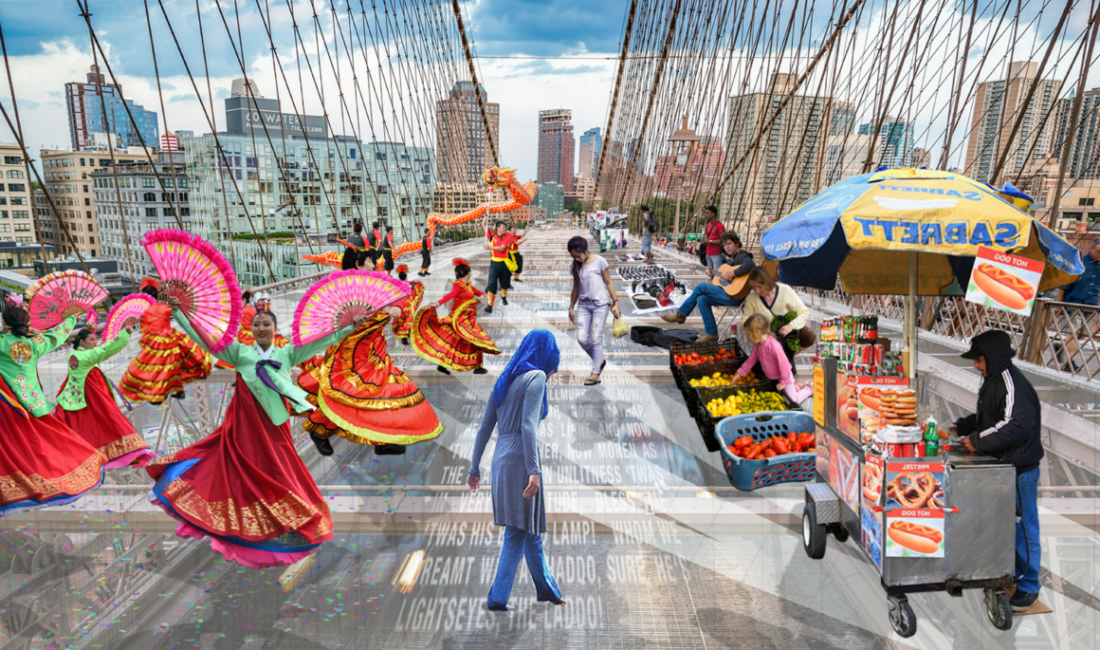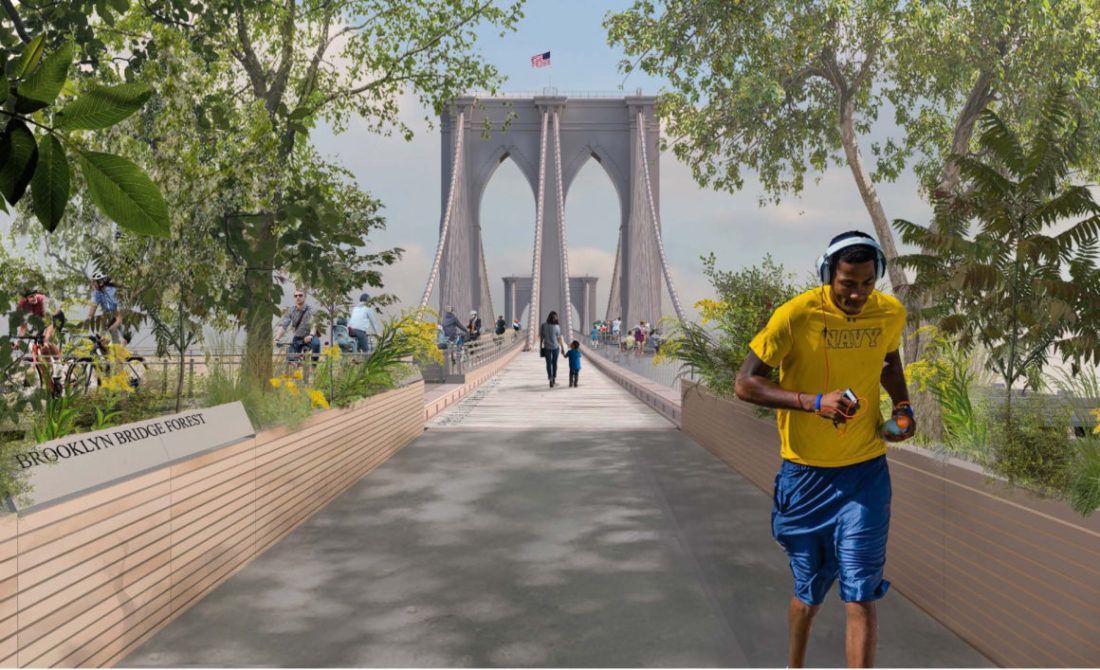Reimagining a New York Icon: Winners Announced for Brooklyn Bridge Redesign Competition


Two winners have been announced for the Reimagining Brooklyn Bridge Competition, hosted by design nonprofit, Van Alen Institute. The winner in the professional category is titled Brooklyn Bridge Forest, submitted by Pilot Projects Design Collective, and the young adult category winner is ‘Do Look Down‘ by Shannon Hui, Kwans Kim, and Yujin Kim of, respectively, Hong Kong, California, and New York.
The iconic Brooklyn Bridge, completed in 1883, is composed of two levels – one on the bottom for cars, which have six lanes to spread out in, and a promenade at the top for pedestrians – and can no longer accommodate the massive populace that has grown up around it in the last century and a half. The promenade is as narrow as ten feet wide in a few spots, meaning that walkers and cyclists compete for space, constantly running the risk of collision. Now, as COVID-19 continues to grip the city, such a constricted space poses more of a danger than ever.
“The conditions that made the pedestrian and bike pathway not really usable in a safe and pleasant way were bad before the pandemic, and now they were just impossible,” explained Deborah Marton, executive director of Van Alen. “Like, you can’t have people squished together the way that they were before.”
The New York Times reported that the average number of pedestrians crossing the bridge on weekdays had increased from 10,484 in 2011 to 13,196 in 2017. The weekend crossings for the same period had soared to 32,453 from 14,145. The Department of Transportation (DOT) released a plan, also in 2017, for relieving some of the congestion, positing ideas like expanding the promenade, creating a separate bike-only entrance on the Manhattan side, and limiting the number of vendors.
No major changes have been made, however. DOT’s Brooklyn Bridge Recommendation Report states that expanding the promenade would require a cable inspection, a process that would take about two years and is currently delayed. DOT attributed these delays to financial challenges that had been further compounded by the city’s recent budgetary restrictions, yet the number of trips across the bridge keeps rising.
Van Alen together with City Council House Speaker Corey Johnson launched the competition in February, to spark conversation about how the bridge, and New York’s infrastructure as a whole, could improve, inviting submissions that make both the promenade – and the road — safer, more functional, and more environmentally sustainable. It received more than 200 submissions from 37 countries.
The competition was born from thinking about “how could we make the bridge a better experience for pedestrians, vendors, people on bikes, and how could it point the way towards 21st-century transit?” explained Marton.
“We understand now that for people to be healthy, and also for our planet to be healthy, we just need to drive less.” While the winning designs won’t actually be built, Marton said, the competition is a way of encouraging people to come up with new ideas.
To make the competition more inclusive, they decided to take equal numbers of professional (age 22 and over) and student (age 21 and under) submissions.
“You know, young people are who [are] going to inherit this city from everyone who’s working on planning and designing it,” said Marton. ”But young people who are still in school or are under 21, really don’t have the resources to turn out the level of professional submission that some of the firms would. But we wanted to know what their ideas were.”

The professional category winner, Brooklyn Bridge Forest design, “triples the capacity for active transit, brings biodiverse forest and green spaces into the city, and establishes a partnership to conserve 200,000 acres of tropical forest,” the competition page states.
“We are energized by this victory for healthier cities and the global environment. Brooklyn Bridge Forest seeks to build a new vision of environmental sustainability and social equity — reimagining this beloved landmark as a way to connect New York City and its residents to forests and natural systems that sustain life for all,” Scott Francisco, Brooklyn Bridge Forest team lead and founder of Pilot Projects Design Collective, told Van Alen Institute.
“We thank Van Alen Institute and the New York City Council for their enormous commitment to this process, and our tens of thousands of supporters in New York City and around the world. We look forward to working with a broad array of stakeholders to advance this vision. Our team is ready and excited to help New York City co-create an optimistic, equitable, and restorative future.”
‘Do Look Down‘ by Shannon Hui, Kwans Kim, and Yujin Kim design “installs a glass surface above the bridge’s girders, creating a whimsical new pedestrian space brought to life by visuals that honor the city’s cultures, histories, and identities.”
“It’s been an incredible experience taking part in the Reimagining Brooklyn Bridge competition, a challenge originally addressing overcrowding that quickly became about so much more,” said Shannon Hui of the Do Look Down team.
“This health crisis, in addition to its intersections with racial and queer injustice, has violently amplified the systemic inequities built into New York’s existing urban infrastructure, and for designers and developers to continue to operate within a vacuum would be to take advantage of a position of immense privilege. We are extremely grateful for the support and resources provided by the Van Alen Institute and the New York City Council to approach this project as an opportunity for us to imagine meaningful public spaces where people can feel seen and heard — and ultimately, belong.”
Both winners were chosen from a pool of six finalists — three each in the professional and young adult categories — through a combination of public votes and scores from an interdisciplinary jury. Other professional finalists included ‘Back to the Future’ by BIG & ARUP and ‘Bridge X’ by ScenesLab, Minzi Long, and Andrew Nash.
Other young adult finalists included: ‘The Artery’ by Lukas Kugler of New Milford, CT, and ‘The Cultural Current’ by Aubrey Bader and Maggie Redding of Knoxville, TN.
One major caveat for the competition was the requirement that designers comply with landmark prohibitions stipulated by the Landmarks Preservation Committee; the bridge is both a National Historic Landmark and a New York City Landmark. It’s also deeply sentimental.
“As a designer, you don’t want to destroy something that is resonant and meaningful to people and their lives,” Morton said. “With that being said, the agency to exist and feel safe in the public realm is – to this day – not afforded to people of all identities. The transformation of a more walkable New York post-COVID should not only be one that addresses mobility, but equity and intersectionality as well.”
Though only one winner was selected from each category, all professional finalists will receive $13,000, while young adult finalists will each receive $3,000.




